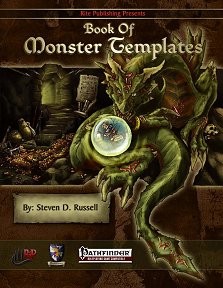
Skipping over the mis-spelling of the author's name on the cover, dive straight in to the Introduction, and a discussion of the whole glorious scope of the template in monster design and modification. Good monsters are a classic staple in fantasy role-playing, yet how many players seem to know them all (even when they don't play budding naturalist rangers who keep field notebooks!) which always takes the edge off the excitement? Templates enable you to put new twists on your monsters without having to spend time inventing completely new ones. No less than 32 templates are included, plenty to keep your monster stable populated and your players on their toes.
So, on to the templates themselves.
A formulaic presentation has been used, so that it is a straightforward matter to lay original monster description and template side-by-side and work through your monster methodically. If even that does not appeal, or you are really in a hurry, there are plenty of examples of modified monster you can use straight off. The samples even have the sort of combat notes and (when appropriate) information on how they think and react, to make running them simple. There are also lore charts, to enable the more learned character to have a chance of knowing something about this strange critter he's just encountered even if his player does not.
Analysing one in detail, the formulaic presentation works well. Starting with a paragraph or so describing what that template actually means, how it affects any creature to which you wish to apply it, each facet of a monster stat block is addressed in turn, making it easy to undertake the conversion. The majority of templates are generic enough to be applicable to any monster from any source, whilst the exemplars are suitable for immediate use as 'variant' specimens of whatever the base monster happens to be, complete with a wealth of apposite information.
One gem, though, is the Aware Arcana template. You apply this not to a monster but to a spell, rendering it capable of following simple directions. It appears like a glowing giant ioun stone, and can emit the original spell as a ray attack... several times! When things get up close and personal they can emit the same effect as a spark instead. They last until destroyed (being vulnerable to dispel magic as well as to taking physical damage, until then they are capable of flight and of acting with basic intelligence. Neat! If your spellcasters like this idea, there is a feat that they can take to enable them to make their own and even a magic item to allow more precise control of them.
Amidst the accursed and betrayers and the like, there is also a civilised creature template. These monsters have either developed their own civilisation and culture, flying in the face of what you would expect of them, or have grown to appreciate someone else's culture to a great extent, often found wearing clothes, using tools and other unlikely actions for monsters widely believed to be savage and animalistic at best. However, most of the templates tend to make their recipients even more monstrous than they otherwise would be... and I'm sure I've met the tax collector! Another interesting template is the weapon contstruct creature: here, perhaps, an explanation for that annoying intelligent sword that gives you backchat at inopportune moments.
Overall, it's a fascinating collection presented in a systematic manner. The templates themselves are ingenious and often spawn adventure ideas, while the sample monsters are ripe with inspiration. Rather too many niggling little errors got past the proofreaders, but nothing that actually renders anything unusable: and use this you will!
Return to Book of Monster Templates page.
Reviewed: 22 December 2010

